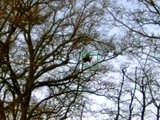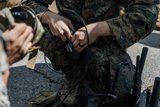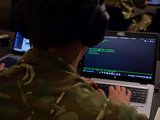EW 2011: Call goes out for unified EW command
The US has been urged to set up a unified EW command and to redefine the electromagnetic spectrum as a domain that needs to be preserved, if it is to avoid an ‘electromagnetic Pearl Harbour’.
Speaking at the Electronic Warfare 2011 conference, Laurie Buckhout, president-elect of the Association of Old Crows, said EW assets across the Department of Defense needed to be brought under an umbrella command, in much the same way as US Cyber Command that was established in 2009.
‘I just left four years in the Pentagon and what it comes down to in terms of building warfighting capabilities is money and you don’t get money unless you have a clear advocate – one person to stand up for your capability,’ Buckhout told the conference in Berlin on 26 May.
Buckhout pointed out that in terms of EW developments, US forces had made some significant progress in recent years.
In the last three years the US Army has established 3,700 officer, warrant officer and enlisted billets devoted to EW and in many areas the major services had collaborated for the first time on EW efforts. The USMC, meanwhile, is moving ahead with its Collaborative Online Reconnaissance Provider/Operationally Responsive Attack Link (CORPORAL) project, a network-enabled, UAS-based, electronic attack capability.
However, the standing up of Cyber Command, which falls under the remit of US Strategic Command, had ‘blurred’ the distinction between EW and cyber threats and responses.
‘I am a cyber-geek myself, I have a clear appreciation and understanding of cyber warfare and cyber operations but is it or is it not electronic warfare? You need to look at what is the genesis of what. And you need to look at the clarity that is currently in electronic warfare – because blurred responsibilities and blurred requirements will not lead to dollars.’
She said proponents of a joint cyber command had used knowledge of the threat to have cyberspace declared as a domain that had to be contested, which carried with it some inherent leadership and organisation ramifications.
‘When EMS is treated like a separate domain then we will really be part of the joint battlespace, or the joint coalition. But we really aren’t at this time. For example one of the big problems we still have in counter IED operations is deconflicting them – and it is very difficult to deconflict everything in the electromagnetic spectrum. It needs to be someone’s fulltime job.’
Another consideration was providing commanders some awareness of how effective the EW assets under their command had been during an operation.
Buckhout said it was very hard to prove a negative; for example, was a jammer effective or was the enemy just not there?
‘It is very hard to prove a negative. And a lot of this stuff is in a security realm where you can’t talk about it, you can’t trumpet your success when you do find out about it. Telling our success stories is very important to do - we tend to be the unsung heroes but when we can document it, it is very important to do.’
She said regretfully it might take an ‘electromagnetic spectrum Pearl Harbour’ for a champion of a unified EW command to push for the concept within the DoD.
More from Digital Battlespace
-
![EID to unveil new vehicle communication system at DSEI]()
EID to unveil new vehicle communication system at DSEI
The Portuguese company’s naval communications system is in service across more than a dozen countries. It has turned to its home nation for support in developing a new vehicle based C2 system.
-
![Chess Dynamics successfully demonstrates Vision4ce AI-driven tracker]()
Chess Dynamics successfully demonstrates Vision4ce AI-driven tracker
The Vision4ce Deep Embedded Feature Tracking (DEFT) technology software is designed to process video and images by blending traditional computer vision with artificial intelligence (AI) algorithms to present actionable information from complex environments.
-
![Wave Relay devices cleared for security use on commercial systems in industry trend]()
Wave Relay devices cleared for security use on commercial systems in industry trend
Persistent Systems has been cleared by National Security Agency (NSA) to transmit sensitive data on commercial networks. The devices are added to the NSA’s Commercial Solutions for Classified (CSfC) component list which also includes other companies’ products providing the same security.
-
![UK teases cyber spending boost in Strategic Defence Review ahead of “imminent” release]()
UK teases cyber spending boost in Strategic Defence Review ahead of “imminent” release
The release of the UK’s Strategic Defence Review (SDR) has been long promised as mid-year. It is possible it could be as early as 2 June although the UK Ministry of Defence (MoD) continues to play its cards close to its chest.
-
![Intelsat emphasises SATCOM resilience for SOF in contested domains (video)]()
Intelsat emphasises SATCOM resilience for SOF in contested domains (video)
Intelsat outlines how its multi-orbit SATCOM architecture is enhancing connectivity and resilience for special operations forces operating in degraded and contested environments.
-
![US Space Force’s next-generation missile warning system moves forward with $500 million in new contracts]()
US Space Force’s next-generation missile warning system moves forward with $500 million in new contracts
Next-Generation Overhead Persistent Infrared (Next-Gen OPIR) satellites are intended to provide early warning of missile launches from any location worldwide and new ground stations will result in expanded coverage of critical missile warning.
























